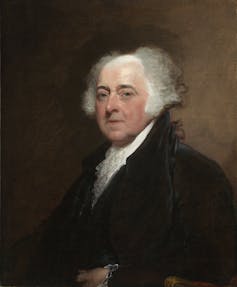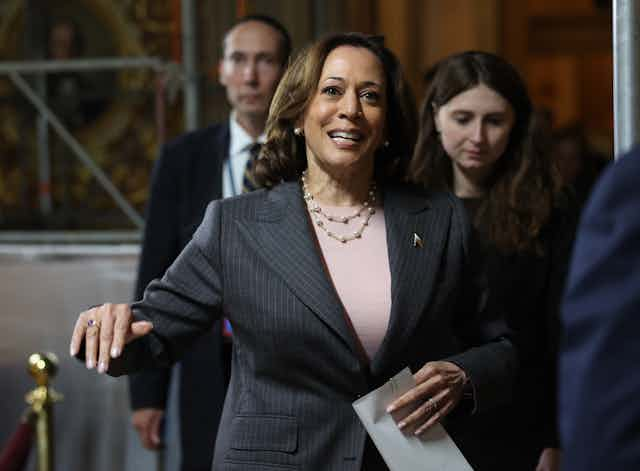On Jan. 20, 2021, Kamala Harris became the first African American, the first person of South Asian descent and the first woman to serve as vice president of the United States.
More recently, she made history again by casting her 31st tie-breaking vote in the Senate, matching only one other vice president’s record for such votes. John C. Calhoun, who was vice president from 1825 to 1832, needed all eight years of his term to reach that number. In contrast, Harris has only been in office for two and a half years.
If her tie-breaking continues, Harris could end up as one of the most consequential vice presidents in history, casting the deciding votes on several laws, judicial nominations and spending plans. However, this distinction says more about the Senate than the amount of power the vice president actually wields.
The ‘most insignificant’ office?

The role of vice president is only mentioned in the U.S. Constitution a handful of times.
Article I, Section 3 says that the vice president “shall be President of the Senate but shall have no Vote” except in the event of a tie. Historically, ties have been rare. Since 1789, only 299 tie-breaking votes have been cast, and 12 vice presidents, including current President Joe Biden, never cast a single one.
The beginning of Article II, Section 1 explains how vice presidents are elected, which was later revised by the 12th Amendment. The end of that section states that presidential power “shall devolve on the Vice President” in the event of the president’s “Death, Resignation, or Inability to discharge the Powers and Duties of the said Office.”
As written, it is unclear whether this meant that a vice president became the new president or was simply serving in an acting capacity. This was later clarified with the passage of the 25th Amendment, which states that “the Vice President shall become President.” The 25th Amendment also outlines how to fill a vacancy in the vice presidency, and it provides a mechanism for the vice president to serve temporarily as president if a president becomes “unable to discharge the powers and duties of his office.”
Finally, Article II, Section 4 states that vice presidents, like presidents, can be “removed from Office on Impeachment for, and Conviction of, Treason, Bribery, or other high Crimes and Misdemeanors.”
So, other than staying out of trouble to avoid impeachment and waiting around to serve as – or replace – the president, vice presidents are really only obligated to occasionally cast a tiebreaking vote in the Senate. This means that the great majority of the time, vice presidents have no real job to do.
John Adams, the first U.S. vice president, once complained to his wife that the vice presidency was “the most insignificant Office that ever the Invention of Man contrived or his Imagination conceived.”
However, not all have been upset about such inactivity. Woodrow Wilson’s vice president, Thomas Marshall, quipped after he retired: “I don’t want to work … [but] I wouldn’t mind being Vice President again.”

The ‘last voice in the room’
Wilson’s successor as president, Warren Harding, had unconventional views about the importance of the role of the vice president. He thought that “the vice president should be more than a mere substitute in waiting,” and he wished for his vice president, Calvin Coolidge, “to be a helpful part” of his administration. Coolidge later became the first vice president in history to attend Cabinet meetings on a regular basis.
In 1923, Harding died, likely of a heart attack, and Coolidge succeeded him as president. “My experience in the Cabinet,” Coolidge later recalled, “was of supreme value to me when I became President.”
After Harding and Coolidge, many later presidents reverted back to the tradition of keeping vice presidents an arm’s length away, even on key matters. Franklin D. Roosevelt, for instance, kept the atomic bomb a secret from Vice President Harry S. Truman, who didn’t find out about it until Roosevelt’s death.
For the 1960 presidential election, two-term Vice President Richard Nixon faced off against Sen. John F. Kennedy. At one point during the campaign, reporters asked then-President Dwight D. Eisenhower: “Can you think of a major contribution that Nixon has made to your administration?” Eisenhower replied: “Well, if you give me a week I might think of one.” Nixon lost that election.
In 1976, Jimmy Carter picked Sen. Walter Mondale as his running mate. In a memo sent to Carter after winning the election, Mondale argued that “[t]he biggest single problem of our recent administrations has been the failure of the President to be exposed to independent analysis not conditioned by what it is thought he wants to hear or often what others want him to hear.”
Mondale’s vision for the role of vice president was “to offer impartial advice” so that Carter wouldn’t be “shielded from points of view that [he] should hear.” Carter agreed and subsequently made Mondale an integral part of his inner circle.
Biden served 36 years in the Senate before leaving to become Barack Obama’s vice president. When he agreed to be Obama’s running mate, Biden said he wanted to be the “last man in the room” whenever important decisions were being made so he could give Obama his unfiltered opinion. When Biden picked Harris as his running mate, he said he “asked Kamala to be the last voice in the room,” to “[c]hallenge [his] assumptions if she disagrees,” and to “[a]sk the hard questions.”

An ally in an increasingly divided Senate
Under the rules of the U.S. Senate, if just one lawmaker doesn’t want a bill to advance, they can attempt to delay its passage indefinitely via the filibuster. A supermajority of three-fifths of the senators, or 60 of the 100, is required to stop the filibuster – or signal that one would not succeed – and proceed to a vote.
Over the years, the Senate has made various procedural changes to the filibuster, limiting when it can be used.
The end result of these reforms is that the Senate is now empowered to do more with just a simple majority. In addition, in recent years, the Senate has become increasingly divided. Together, this has created the conditions that have empowered Harris to cast so many tie-breaking votes so quickly, solidifying both her place in history and her place alongside Biden in the 2024 election.
This is an updated version of an article initially published Jan. 19, 2021.

